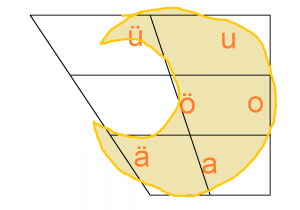User:Ceige/Unnamed: Difference between revisions
Jump to navigation
Jump to search
No edit summary |
(Added vowel shiz) |
||
| Line 86: | Line 86: | ||
Essentially, the differences between older forms of the language and newer forms is that the newer forms avoid any and all clusters by making them geminated consonants. | Essentially, the differences between older forms of the language and newer forms is that the newer forms avoid any and all clusters by making them geminated consonants. | ||
===Vowels=== | |||
The '''core''' vowels in their traditional groupings: | |||
[[File:Crescentvowels2.png|300px|thumb|right|Crescent Vowel diagram showing the realisation of the vowels affected by vowel harmony.]] | |||
{| border="1" cellpadding="1" cellspacing="1" class="bluetable lightbluebg" style="width: 330px; text-align:center;" | |||
! style="width: 68px; "| | |||
! style="width: 68px; " |Front | |||
! style="width: 68px; " |Near Front | |||
! style="width: 68px; " |Back | |||
|- | |||
! style="" |Close | |||
| i | |||
| ü | |||
| u | |||
|- | |||
! style="" |Mid | |||
| e | |||
| ö | |||
| o | |||
|- | |||
! style="" |Open | |||
| | |||
| ä | |||
| a | |||
|} | |||
The shape of vowels that aren't e/i (which are considered additional epenthetic vowels) has been referred to as ''crescent shaped''. This is because of how they are realised (see diagram). | |||
Revision as of 12:03, 7 November 2014
Phonology
Consonants
The consonants are grouped into their traditional classifications.
| Labial | Dental | Palatal | Velar | Glottal | |
|---|---|---|---|---|---|
| Plosive | p | t | s | k | ʔ |
| Fricative | v | ð | z | g | |
| Sonorant | m | n | j | ||
| Lateral | l |
The single lateral counts as everything but labial
Notes for the older form of the language
On assimilation where clusters arise...
- Any two plosives that come in contact result in a geminated version of the second plosive.
- akta > atta
- atpa > appa
- aʔka > akka &c.
- Any two fricatives that some in contact result in a geminated version of the second one's corresponding plosive.
- aðga > akka
- avða > atta &c.
- Any plosive or fricative that comes before a nasal will result in its gemination.
- apna > anna
- but
- apja = apja (while aja appears dialectally, it is not part of the most achaic level of the language)
- Any fricative that comes after a nasal will be converted to a plosive.
- anða > anta
- Furthermore, the nasal will match the traditional place of articulation (TPOA) of the plosive, even if it means becoming denasalised.
- anza > ajsa (this is largely historical).
- Where two non-sonorant (sonorant excl. laterals) consonants of the same TPOA come in contact, it tends to result in the gemination of the second consonant. For this, the lateral counts as
- aðta > atta
- atla > alla
- but
- apla = apla
- There is one exception: L can precede any consonant (although historically it shifts to J before S)
- alta = alta
Notes for the speech of (X LARGE AND NEW) group
On assimilation where clusters arise...
- Plosives with plosives, fricatives with fricatives, etc et al, form geminates
- atka > akka
- aðpa > appa
- Anything next to a nasal forms a nasal geminate (not in the older form)
- amna > anna
- anta > anna
- All dentals next to a lateral form a lateral geminate (not in the older form)
- alka > alla
- alna > alla
- Remaining laterals are absorbed into geminates if at the front, and vice versa.
- alma > amma
- amla > alla
- apla > alla
- alka > akka
- alsa > assa &c.
- For fricatives, this can result in the lateral being dropped, or the same as above.
- alga > aga, akka (These are called "dissonant gradation pairs").
Essentially, the differences between older forms of the language and newer forms is that the newer forms avoid any and all clusters by making them geminated consonants.
Vowels
The core vowels in their traditional groupings:
| Front | Near Front | Back | |
|---|---|---|---|
| Close | i | ü | u |
| Mid | e | ö | o |
| Open | ä | a |
The shape of vowels that aren't e/i (which are considered additional epenthetic vowels) has been referred to as crescent shaped. This is because of how they are realised (see diagram).
